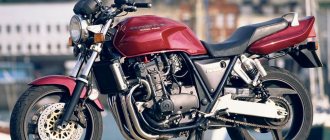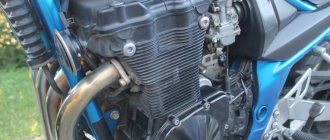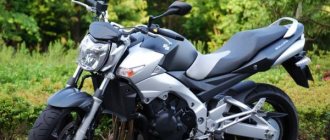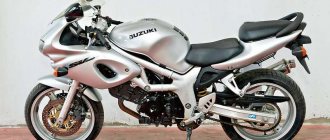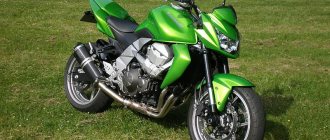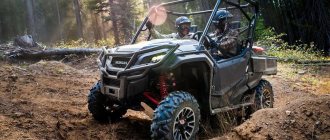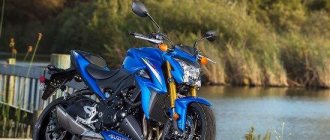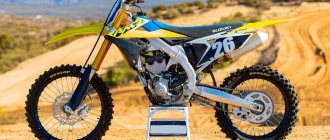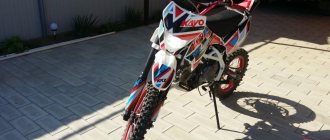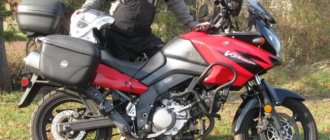A few years after the launch of the naked SV650 series, Suzuki engineers decided to create an older, flagship version with an engine capacity of 1,000 cubic meters . In 2003, the first sample of the Suzuki SV 1000 appeared, and production began in the same year. The motorcycle largely replicates the appearance of the younger version. There are also a few differences in the filling, taking into account the fact that it is a liter. It should become more powerful, faster, more dynamic, etc.
Bad results
There are many positive qualities in the SV 1000, but none of them allow us to clearly qualify the motorcycle.
But such copying led to an unexpected result.
The new version sold poorly. Even the fact that this bike was offered not only for export did not save the situation.
It was also possible to meet him in domestic markets. In 2007, the company came to the conclusion that the production of a liter was no longer profitable , warehouse stocks were sold out and the Suzuki SV 1000 became history.
During its short life, the motorcycle received several ergonomic and cosmetic changes. There were no major restylings. The only noteworthy detail is that the Suzuki DL1000 V-Strom .
Brief history of the model
2003 - start of production and sales of Suzuki SV1000. Model: Suzuki SV1000; Suzuki SV1000S (Japan, Europe, North America, Australia). Factory designation: SV1000K3; SV1000SK3.
2004 - the usual modification of the Suzuki SV1000 was slightly revised, in particular, the ergonomics were changed - the footpegs began to be located lower, and the height of the saddle also decreased. Model: Suzuki SV1000; Suzuki SV1000S (Japan, Europe, North America, Australia). Factory designation: SV1000K4; SV1000SK4.
2005 - The model receives a black frame and wheels, larger throttle valves and an increased compression ratio. Starting this year, export modifications produce up to 125 hp. power (instead of the previous 120 hp). A commemorative version of the Suzuki SV1000SZ is offered in some countries and features the color scheme of the GSX-R series. Model: Suzuki SV1000; Suzuki SV1000S (Japan, Europe, North America, Australia). Factory designation: SV1000K5; SV1000SK5.
2006 - no significant changes. Model: Suzuki SV1000; Suzuki SV1000S (Japan, Europe, North America, Australia). Factory designation: SV1000K6; SV1000SK6.
2007 is the last year of production. Model: Suzuki SV1000; Suzuki SV1000S (Japan, Europe, North America, Australia). Factory designation: SV1000K7; SV1000SK7.
Specifications
The motorcycle received its engine from a sportsman Suzuki TL1000. Its power was reduced, which allowed it to level out traction throughout the entire rev range.
| Suzuki SV1000 | parameter |
| Motorcycle class | naked |
| Year of production | 2003-2007 |
| Frame | aluminum cast |
| engine's type | 2-cylinder, 4-stroke, liquid cooled, fuel injection, SDTV, L-shaped pistons (V-shaped forward) |
| Working volume | 996 cm³ |
| Bore/Stroke | 98.0 x 66.0 mm |
| Ignition type | transistor |
| Maximum power | 94.0 hp (69.1 kW) at 8500 rpm – SV1000 / SV1000S (Japan) 120.0 hp (88.3 kW) at 8500 rpm – SV1000 / SV1000S (except Japan) 2003-2004 125.0 hp (92.0 kW) at 9000 rpm – SV1000 / SV1000S (except Japan) 2005-2007 |
| Maximum torque | 102.0 Nm (10.3 kg*m) at 7000 rpm |
| Transmission | 6-speed |
| type of drive | chain |
| Front tire size | 120/70ZR17M/C (58W) |
| Rear tire size | 180/55ZR17M/C (73W) |
| Front brakes | 2 discs, 310 mm, 4-piston calipers |
| Rear brakes | 1 disc, 220 mm, 1-piston caliper |
| Front suspension | Telescopic fork 46 mm (all adjustments), travel - 120 mm |
| Rear suspension | Pendulum with monoshock absorber (all adjustments), stroke - 130 mm |
| Minimum ground clearance (clearance) | 150 mm |
| Acceleration to 100 km/h | 3.08 sec |
| Acceleration to 100 km/h | 3.08 sec |
| Comfortable cruiser | 120 km/h to 160 km/h |
| Maximum speed | 235 km/h |
| Gas tank volume | 17.0 l |
| Power reserve | 200-250 km/h |
| Fuel consumption | 5.44 l. per 100 km |
| Motorcycle weight (dry) | 186 kg |
Features include fuel injection , SDTV , L-shaped pistons ( V-shape pushed forward ). And also slightly reduced characteristics for installation on bikes that are planned for sale in domestic markets. Otherwise it is a standard 2-cylinder , 4-stroke liquid-cooled engine .
Two-cylinder engine.
Cooling system radiator.
Classic chain drive.
Transmission and clutch
The engine was equipped with a 6-speed gearbox.
There are no complaints from users about it - the numbers are convenient, gears are engaged without questions, neutral is found immediately. Elasticity is noted: accelerating to 100 km/h in first is no problem, 25 km/h in sixth - please, on the highway at 200 km/h - no problem!
- The clutch is standard - in an oil bath , power transmission is hydraulic .
- The main drive is standard - chain .
Brakes
Front brakes.
Rear brakes.
There are complaints about the rear brake. According to reviews: “ It’s as if it’s not there, but nevertheless the pads need to be changed .” There are no other problems . Hydraulic discs. 2 discs on the front 1 disc on the rear . The diameter of the brake rotors is 310/220 mm . 4-piston brake caliper at the front, 1-piston at the rear.
No options are offered.
Description
The Suzuki SV1000 series of road motorcycles appeared in 2003 and was focused mainly on the export market - Europe, North America, Australia. Unlike the younger version (Suzuki SV650), the SV1000 was also officially sold in Japan - Japanese modifications have a limited engine power of 94 hp.
The Suzuki SV1000 model is the older version of the SV650 model and has an almost identical appearance with it. The main differences are in the engine, intake system and chassis (frame, pendulum, suspension, brake system). If we give a short description of the SV1000, we can say that it is the same second-generation SV650, but with more expensive equipment. However, despite this, the “younger” was in much higher demand.
Main modifications of Suzuki SV1000:
Suzuki SV1000 is a regular naked version. It features a high handlebar and a classic round headlight. Suzuki SV1000S - sports version. It has a front fairing with double headlight and lower plastic. It also features clip-ons and high footrests, making the seating position more pronounced forward. The SV1000 was based on a 2-cylinder V-twin liquid-cooled engine with a volume of 996 cm³, producing up to 125 hp. power and up to 102 Nm of torque. The engine was carried over from the sports version of the Suzuki TL1000 and was retuned for smoother traction at low and medium speeds. This type of motor is often called L-shaped because of its characteristic forward tilt.
This engine was also installed on the touring enduro - Suzuki DL1000 V-Strom.
Key features of the Suzuki SV1000, in addition to the engine, include a die-cast aluminum frame, sports fuel injection (injection with dual SDTV throttle bodies), powerful 4-piston front brakes, fully adjustable suspension, hydraulic clutch, 6-speed gearbox and 186 kg dry weight. .
2007 was the final year of production for the SV1000 model series, after which it disappeared from dealers and was removed from Suzuki's international website. Despite the interesting concept and impressive technical characteristics, the model did not receive further development.
Driving performance
The maximum speed declared by the manufacturer is 235 km/h . The owners say that the acceleration is normal, but you can’t give it more than 170 km/h , the headwind simply interferes. Moreover, although the Japanese deny it, there is a limiter at 195 km/h . Comfortable cruiser over a wide range from 120 km/h to 160 km/h .
Only the S version, a sporty modification of the model, can be called a comfortable cruiser. In the regular naked version, any wind protection is completely absent.
Peculiarities
“Esveha” is best suited for the city and medium-range.
Although the motorcycle had much in common with the younger model, it nevertheless had its own unique features.
- Vibration . The steering wheel and tank shake constantly while driving. There is no treatment. After 100 km of running, my hands begin to ache.
- Landing . High footpegs seem to set you up for a sporty riding position. The original saddle does not hint at long trips.
- Pendant . All adjustments provide a wide range of variations, but the factory settings are quite suitable for driving on Russian roads.
- Motorcycle for one . Although the second number accelerates well, controllability and maneuverability decrease. The footpegs and handles for the second number are, by and large, decoration, and leaning forward when driving fast prevents it from sitting down.
- Good handling , while the center of gravity is located quite high.
- Excellent maneuverability , although the large size is noticeable in traffic jams.
- Japan . Unlike the younger version, which had a modification for domestic markets ( 400 cc ), liter models supplied to domestic markets were simply artificially “strangled” from 125 horses to 94 .
Sometimes they note that the motorcycle overheats when standing for a long time with the engine running (the fan spins constantly, and you can fry an egg on the muffler), but when you reach at least 30 km/h , the temperature returns to normal.
Review of the Suzuki SV 1000 motorcycle
The first thing you immediately feel is the bike’s composure. It handles uneven asphalt perfectly, there is no bumpiness characteristic of steel frames. As a result, you can invest in turns even in the pits and still feel absolutely confident. The bike is very light, throwing it from side to side in traffic is a pleasure.
The seating position is quite comfortable, but not suitable for long-distance driving. The tank is disgustingly small - 17 liters is enough to drive from refueling to refueling; if you rush at under 200, overtaking a line of summer residents, then it is enough for 100 kilometers (which is 40 minutes in total). It’s not like the whole tank flies away, but I already want to refuel.
The seat is terrible, I never bought a gel one, I struggled with my original one for three years.
The V-shape engine is a special story. It seems like yes, a pull from the bottom, a noble sound unusual for sports. But is it worth those terrible vibrations that make your fingers go numb after 100 km? ways.
In general, now only a soldier. Yes, and there is no pick-up at high levels, which is typical for row soldiers, but I really want it. The smooth acceleration curve and lack of high-revving engine squeal are not for me.
I can’t say anything about the reliability of the bike - it didn’t break. I haven’t done anything to it at all, for 7000 miles, I’ve never even changed the oil, although I probably should have. You come in the spring, light a cigarette, start it and go.
The device looks good on the road, seeing predatory headlights, cars quickly fall off the lane. It is not surprising that all these years the model has not undergone restyling. Appearance still looks good. Despite the ambiguous landing, the Suzuki SV1000S can still be driven easily in the city, and even more so outside of it. In an hour and a half I managed to ride it to Chekhov near Moscow and back. I checked the wind protection at all speed levels (only 170 km/h is not comfortable) and fuel consumption (at a full “hole” it reaches some kind of automotive appetites). I didn’t feel particularly tired.
I made my first trip to a gas station, I thought I’d take it for a quiet ride and see what it was like. But it was not possible to leave immediately - the battery died. I installed it from Bros, fortunately it’s the same size, only the height is smaller. At the second traffic light I decided to show TAZovod, who stopped nearby, who the super bison was. A little more gas (I turned it about five thousand, no more), released the clutch a little faster (I didn’t even drop it!) and the rear wheel, shod in Diablo Corsa, went into axle. Gentlemen, I've lost my shit (s). The body, which had become unaccustomed to motorcycles over the winter, quietly went crazy from the dynamics. The engine spins easily up to 11,000 rpm, and in first gear you can accelerate to more than 100 km/h. In general, the first trip was completely positive, with the exception of one thing - the sound from the standard exhaust pipes. A hoarse howl interspersed with a chatter at high speeds is not at all pleasing. At low levels it’s like a tractor. Angry tractor.
In place of the Suzuki, with its 189 kg of dry mass, it is perceived to be heavier than Bros, and the center of gravity is clearly higher. When driving, the feeling that you are driving a large motorcycle does not go away. Later, of course, I got used to it and, when I rode Bros, I wondered how I could ride this moped before.
And then there was a trip to Obninsk in the company of two blackbird breeders. I barely had time to hang up the number when I had to go to a meeting with them. There it turned out that Drozd, loaded with a passenger, was still going steeper than my Susa. Messing with him led to the fact that after just 15 seconds of the trip I hit the speed limiter at 195 km/h. Fak. What a bummer (also, if anyone is interested, Drozd’s muffler exhausts are not only longer, but also thicker :). But I liked riding the SV1000S more and more. You can keep the cruising 160 for a very long time; if you go faster, you have to lean on the tank. Gasoline consumption for this trip was around 7 l/100 km, which, considering the speed of travel, is very good.
After a week of riding, I had to adjust the levers on the steering wheel. I placed the brake handle as far as possible from the steering wheel so as not to pinch my fingers during heavy braking. On the contrary, I placed the clutch lever closer and turned it a little downward, otherwise in the standard position my wrist began to hurt wildly after half an hour of driving, since the clutch is hard and begins to grab at the very end, and my fingers are not particularly long. I didn’t see the advantages of the hydraulic drive, I just added a jar with tests on the steering wheel.
Then motorcycle everyday life began. I went to Tula and Yaroslavl for their season opening. To Voronezh - just like that, in company with the cadets. True, he was alone there, but the convoy was vomiting at 85 km/h all the way. I almost died of boredom. The landing was exhausting, after 200 km of such a trip the seat turned into a hard piece of rubber, the ass begged for mercy, moving back to the passenger side helped a little, but not for long. On the way back, already in the Moscow region, it was raining at 150 km/h, everything was very stable and predictable, despite the worn out rear tires.
The riding position on the Suzuki is, of course, not long-range, but tolerable, especially if you are not traveling with a heavy backpack. The main problem is the placement of things. Travel bags cannot be pulled tightly onto the narrow sides of the tail, which is why the plastic gets scratched very quickly. There is nothing to attach the tent and foam except to the hooks near the passenger footrests. The handle behind the seat is screwed on, obviously for beauty, but it does no good. At first I tried to fasten things using it, but after the paint started to wear off, I gave up on it. It’s good that the tank is steel and you can attach a bag to it with magnets.
Gasoline consumption greatly depends on driving speed. I achieved a maximum consumption of 9 liters per 100 km while passing the Dubasser standard RB-500 along the Simferopol highway. I kept my speed at 170-190, and didn’t slow down even at checkpoints, although once I had to slow down when some fool with a hairdryer rushed across me, waving a striped stick. He defiantly shifted down two gears and drove on. On the way back, the guy realized his mistake and no longer tried to slow me down, but only looked at me with an angry look. And so the average consumption on the highway is around 6.5 liters. If you drive, following the rules, which for a long time, in principle, is not possible, then it comes out to 5 liters, or even less. The tank holds 17 liters of all sorts of rubbish, which for some reason is called gasoline. The reserve lamp is kind of weird, it lights up when there are still 4 liters of fuel splashing in the tank, then it goes out and lights up again after ten kilometers. If you don’t get crazy, you can drive 200-220 kilometers and turn on the lamp. By the way, the 92nd SV1000S is praised for its sweet soul, no detonation and no loss in dynamics. Vibration is felt on the steering wheel and tank, and always. At the same time, everything is clearly visible in the mirrors, even at maximum acceleration.
In the city, the SV1000S fits between cars quite normally, not comparable to Bros, but tolerable, especially since driving speed in a traffic jam depends more on the driver than on the motorcycle. The engine gets quite hot, the fan runs almost constantly, and your feet get burned on the frame. But as soon as you accelerate to 30 kilometers per hour, the temperature drops to normal 85-90 degrees. The main disadvantage, compared to the Honda FireStorm, is the mufflers, which are quite wide and run parallel to each other, and do not taper towards the rear wheel, like the Honda. Despite this, in the aisles, I never caught anyone. The steering angle is not very large, or maybe it seems so because of the fairing, but changing lanes in dense traffic jams is more difficult than on Bros. In first gear, with the gas released, Suza goes 12 km/h without a hint of jerking, in second - 17 km/h. Sometimes it's convenient. There is plenty of thrust in the engine, it happened that I started off in third gear.
The dynamics of acceleration differ for the better from the 650th Bros, but not dramatically, however, with a passenger, the SV1000S accelerates faster than a Honda without a passenger.. The first gear ends somewhere at 110 (at 11 thousand rpm), in the third , when the tachometer enters the middle of the red zone, you can see 195 on the speedometer, and then the speed limiter is activated. Cruising speed ranges from 120 to 160 km/h. The seat doesn't allow you to drive less; your back gets tired quickly. Faster - the wind gets in the way, you have to bend over to the tank. The engine characteristics are almost linear, up to 5 thousand. It just drives well at rpm, after six it turns into a small jet, starting to roll even more dynamically, without jerking or failing, at 9 thousand it starts to fade, but you don’t care anymore and you want to spin it endlessly and only the proximity of the red zone forces you to shift up. The bike responds to clutch throws with strong jerks, even in the sixth. The main thing is that the revolutions do not fall below 2500 and the motorcycle will pull out of any gear. On the first one it was a goat with gas, but on the second I didn’t try it because it was scary. But I don’t drive like that, once it happened that I was holding on to a liter FireBlade for ten kilometers along the Moscow Ring Road, I don’t want to do it anymore.
The brakes are good, dual discs up front with Tokiko four-piston calipers. Relatively soft and predictable, there has never been a time when they did not allow me to stop where I wanted. The rear brake is a hat. It doesn't really slow down, but it eats up the pads.
I really appreciated the standard steering damper, even though it is not adjustable and does not have an Ohlins sticker, but it really helps on the road. On Bros, the steering wheel constantly wobbled on large bumps; thicker oil and additional springs did nothing. Driving a Suzuki, everything is much calmer, the steering wheel hardly moves, you drive and enjoy. Of course, this is not only due to the damper. The front fork handles small bumps just amazingly, it happened that you passed some kind of crap on the road and thought: “is that all over?” The factory settings are quite soft, but they suit me, just for fun, I increased the spring preload a little. I didn’t touch other adjustments, since the suspensions are quite suitable for driving around the city and highways near Moscow. The rear shock absorber, fortunately Ohlins, did not impress in any way, works and works. Maybe it's a little harsh for solo riding, but oh well. There is enough ground clearance to avoid hitting speed bumps or other road hazards. At first glance, the bottom plastic hangs low and should cling to everything, but, in fact, it is located only around the exhaust manifold and there is nothing underneath.
Driving with a passenger is no joy, for both of you. The riding position on the motorcycle is sportbike-style, the butt sits on the very edge of the seat, trying to rest against the tank, steering is difficult, and the weight distribution is generally incomprehensible. You can still drive 100 kilometers, then your arms begin to fall off. In general, screw them, these passengers, let them ride on choppers.
Mirrors are 50% working. If you wear a raincoat, then by 30%. It happened that in the rain I would wrap my forearms with tape, otherwise nothing could be seen. The instrument panel is legible even in sunny weather, but it is low, the chin bar of the helmet can cover the speedometer, you have to look away from the road and tilt your head, especially since the indicator lamps are also not visible. The numbers on the speedometer are large and easy to read, but they are located too close to the top edge of the screen, it can be difficult to understand what speed is 91 km/h or 97. Thanks to the fairing, the tidy always remains dry, even if the motorcycle is standing still. Two headlights with H4 lamps illuminate the road at night very well. Bros' headlight is remembered as a bad dream, especially the high beam. Narrow headlights shine better and further, most likely I won’t install xenon. The LED brake lights are nice, but not visible in bright sunshine.
To date, Suzuki has covered 14 thousand kilometers. In terms of operating costs, the SV1000S is not much more expensive than Bros. At the seventh thousand mileage the rear tires died, I installed Bridgestone BT-012, 15-20 thousand should be enough. Diablo Corsa is still installed in front, maybe 5 thousand is still enough. I replaced the rear brake pads; there were still Japanese ones; the front ones weren't even half worn out. The chain and sprockets were already dying when purchased; they were replaced by JT sprockets and a “reinforced” RK chain. I changed the oil and filter twice, the spark plugs and the air filter once. That's all.
To summarize, I can say that I am almost completely satisfied with the motorcycle. I got what I wanted. Of course, it could be better suited for long-range driving and consume less gasoline, have a bassier exhaust or sit more upright, but all these are minor things. The main thing is that the motorcycle has a lively engine, which allows you to simply ride, have fun and not bother with maximum power and speed. Isn't this the most valuable thing about riding a motorcycle?
